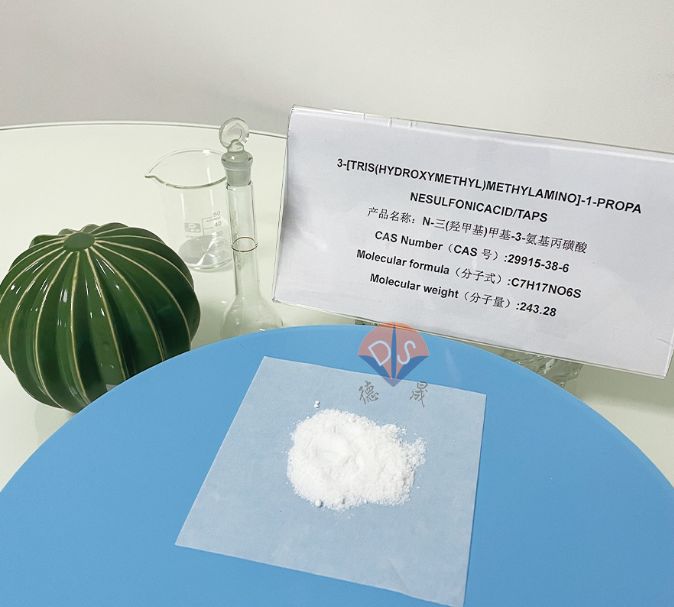TAPS Buffer Operation Guide
Release time:
2025-08-06
In the field of biochemical experiments, maintaining the pH stability of the reaction system is crucial, and TAPS buffer, as a commonly used biological buffer, plays an indispensable role. It has a wide range of applications in numerous experiments, especially those involving nucleic acid DNA and RNA. Proficiently mastering the operation method of TAPS buffer, understanding its characteristics, preparation points, usage scenarios, and precautions, can help experimenters better utilize the role of TAPS buffer in biochemical experiments.

TAPS powder
Basic characteristics of TAPS buffer
1. TAPS stands for N-tris (hydroxymethyl) methyl-3-aminopropanesulfonic acid, with a CAS of 29915-38-6. From a chemical structure perspective, TAPS molecules contain three hydroxyl groups, which endow them with good hydrophilicity and make them highly soluble in water. Every 100 grams of water can dissolve 50 grams of TAPS, which makes the preparation of the solution relatively simple. TAPS can be directly dissolved in deionized water. The buffering range of TAPS is 7.7-9.1, which precisely meets the needs of many biochemical experiments. Within this range, TAPS can resist the effects of acid-base changes in the system, maintain the stability of the pH value of the reaction system, and ensure the smooth progress of the experiment.
Preparation method of TAPS buffer solution
1. Reagent preparation: Prepare TAPS powder and solid sodium hydroxide (if sodium ions need to be eliminated, use solid potassium hydroxide).
2. Solution preparation: Weigh appropriate amounts of TAPS powder and solid sodium hydroxide separately, dissolve them in deionized water, prepare solutions, and mark them as A solution and B solution respectively. During the preparation process, it is important to ensure that the reagents are fully dissolved by stirring appropriately to accelerate the dissolution process.
3. pH adjustment: Adjust the mixing ratio of solution A and solution B according to the required pH value, referring to the following ratio:
When a solution with pH 4.6 is required, the mixing ratio is 1000ml (A)+0ml (B), i.e. (A): (B)=5:0;
If a solution with pH 7.8 is required, mix 1000ml (A) with 200ml (B), (A):(B)=5:1;
For a solution with pH 8.3, take 1000ml (A)+400ml (B), (A): (B)=5:2;
To obtain a solution with pH 8.6, mix 1000ml (A) with 600ml (B), (A):(B)=5:3;
If a solution with pH 9.0 is required, mix 1000ml (A) with 800ml (B), (A):(B)=5:4。
4. Accurate adjustment: To prepare a buffer system with a more accurate pH value, you can first prepare it according to the above method and then use a pH meter for measurement. According to the measurement results, slowly add solution A or solution B for fine-tuning until the desired pH value is reached. During the adjustment process, it is important to stir the solution thoroughly after each addition before measuring the pH value.
Precautions for using TAPS buffer
1. Temperature control: When preparing the solution, it is recommended to control the temperature at room temperature of 20 degrees. The change in temperature may affect the solubility and buffering performance of TAPS. Maintaining an appropriate temperature helps ensure that the prepared buffer solution has stable performance. If prepared in environments with excessively high or low temperatures, it may cause a deviation in the actual buffering range of the buffer, affecting the experimental results.
2. Reagent purity: The presence of impurities may interfere with experimental reactions, affect the buffering effect of buffering agents, and even cause side reactions with other substances in the reaction system, leading to deviations in experimental results. Therefore, when purchasing reagents, it is necessary to choose suppliers with reliable quality to ensure that the purity of the reagents meets the experimental requirements.
3. Operating standards: During weighing, dissolution, mixing, and other operations, strict adherence to experimental operating standards is required. Accurately weigh the reagent mass to ensure that the solution is fully dissolved and mixed evenly, avoiding inaccurate concentration or uneven pH value of the buffer solution due to improper operation. At the same time, when using a pH meter for measurement and adjustment, it is necessary to follow the operating procedures of the pH meter and calibrate it regularly.

Product packaging
As a manufacturer of TAPS buffer raw materials, Hubei Xindesheng always adheres to the principle of quality first. With the improvement of production technology and strict quality inspection process, the TAPS raw materials produced have high purity, low impurities, and stable performance. Equipped with a professional team, we provide customers with professional technical support and thoughtful services, helping them smoothly carry out research and production in the field of biochemistry. If you have purchasing intentions, please feel free to click on the website for consultation at any time!
Previous page
Previous page
News
Contact details
Contact number
Address: C8, Guanggu United Science and Technology City, Ezhou City, Hubei Province
Fax:0711-3704 589
Follow us



